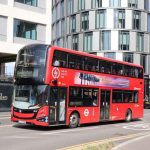In 2018 a project began to equip 28 battery-electric buses with technology capable of returning power back to the network. How does the operator benefit?
Conversations about the prospect of using reserves of power stored in electric vehicle (EV) batteries are not new, and as long as the concept of vehicle to grid (V2G) charging has existed – where plug-in electric vehicles are used to return electricity back to the charging network – there have been discussions about using it in a bus application.
The bus to grid concept is now taking shape. Pioneered by electric utility SSE Enterprise, BYD, UK Power Networks, tech provider Origami, and the University of Leeds, the project began in July 2018 at a London bus depot and will result in one of the single biggest trials of V2G technology in Europe. 28 battery-electric double-decker buses in Go-Ahead London’s Northumberland Park depot will be equipped to supply 1MW of energy back to the national grid, when demand requires.
To find out more, routeone speaks with SSE Enterprise to discuss the work behind the project, how the technology is set to function in a bus depot application, and how operators stand to benefit commercially.

A flexible future through vehicle to grid charging
The thinking behind vehicle to grid technology is relatively straightforward.
As the UK moves away from traditional fossil fuel power and into variable renewable sources such as wind and solar, utilising stored and surplus energy from other sources has the potential to provide a flexible solution to energy demands. A bus depot filled with battery-electric double deckers could be a useful resource when their stored energy is not in use. And, in theory, the operator will be able to benefit commercially by taking energy from the grid when it is cheaper, and returning it when it is not.
But when can that happen, how much does this additional infrastructure cost, and just how practical is it to tap into that energy supply?
Project Development Engineer at SSE Enterprise Jennifer Yates reveals that understanding the operational constraints within the bus industry has been one of the biggest learnings in order to integrate this type of technology. After all, it is important when tapping into a bus depot as an energy supply that the process does not interfere with the operation of those buses, and to ensure that each vehicle will still have enough power to perform its daily duties.
“Whereas a static battery allows flexibility within its own technical constraints, learning how to do what we do to a static battery, which then has to go out and move people around London, has been really difficult,” Jennifer explains. “We’re still grappling with the issue of what can we do to it and how much can we do to it, while still leaving it available for that primary purpose of mobility.” As part of the energy modelling work that SSE has undertaken, it has simulated bus routes with theoretical tools to know exactly what time the buses have to stop discharging and start charging again.
Everything from revenue calculations to capacity calculations have been modelled around that constraint, and when the trading begins, there will be failsafes in place to ensure those red lines are adhered to.
Despite many outcomes being unknown, Jennifer says that SSE went into the project with some confidence. “We had a strong idea that technically it would be viable. At the end of the day, it is a battery – we’ve worked with those before, and we’ve worked with electric vehicles before. It’s been a huge learning curve in a lot of ways simply because it’s the first project of its kind.”
Being a pioneering endeavour has immediate benefits. Until now, a bus has never been used to generate electricity onto a network. Networks are necessarily cautious about that. But now that SSE has gotten the relevant certification to roll out the technology, the bus to grid charging system can be trusted.
Each vehicle battery has a capacity of 382kW/h and can discharge back onto the grid at a rate of 40kW. The total swing of 1.1MW is significant compared to other trials. “Although it might seem, when you look at the whole system, that it is not a huge amount, it’s very significant for these vehicles and the grid trials because this is a young technology. If we could expand this to other buses, just within London, there is a huge amount of power available there,” says Jennifer.

New business models
The primary business case for the installation of vehicle to grid into the Northumberland Park depot has been to control variations the grid’s system frequency. The national grid operates at 50Hz, and must be maintained at that level within a 1% variation. If the network becomes unbalanced, that can be addressed using assets capable of putting more generation onto the system, such as vehicle batteries.
An example of when system generation dropped critically low was during blackouts on 9 August 2019, when the loss of two generators after a lightning strike resulted in disruption to a million customers. Flexible technology such as V2G could, potentially, provide part of the solution to that loss of power generation.
Other business cases for V2G include trading energy out of the buses in an arbitrage system, demand side response (DSR) to ease peaks in demand, or the ability to turn the charging off across the entire depot and discharge back on, providing a large swing in the network.
Operators could be paid for discharging back on to the network, or they may benefit from peak avoidance, discharging at times when they can be paid extra and taking power off the network when it is more abundant. The latter is more an element of the concept of smart charging, but plays into the vehicle to grid system as a whole.
Of course, this raises the issue of whether such a system is practical for a bus garage – and according to Jennifer, SSE is not expecting a huge amount of money from time of use revenues for this specific project. “The energy model that we are working on at the minute is to ask ‘what is the availability of the buses’ because it is not as straightforward as it first seems,” she says. “With the various different routes, it is unlikely the buses are going to hit peak charging points. While they might not have access to that kind of time of use, it’s always a possibility they might, so that isn’t always a great commercial benefit but it is something we need to consider.”
“as the whole system slowly moves to this more flexible kind of operation, we will see huge benefits from V2G and the ability to manage charging and provide power as we need it”
As a result, the trading and balancing work at Northumberland Park will primarily take place at night. Other vehicle to grid projects, such as those in rural depots, may have a different business case; it is hard to say how the findings from Northumberland Park depot in London will translate to a project in Scotland or Wales. But this project is not about chasing any particular kind of revenue.
Frequency response, DSR and Triad avoidance are all options that can be explored and every V2G project will present an individual revenue stack and services to provide for the local network operators.
“This isn’t about there being a business and some technology, plug and play,” adds Jennifer. “And as it becomes more common, people will understand it better and as we do it with more operators and in different locations, it will become easier to offer a turnkey solution. At this stage, we are not there, but that is where we hope to go.” There are, of course, capital outlay costs to consider. A generation connection to the network adds cost. There are G99 mains protection relays to install, additional equipment is needed on the buses, there is additional infrastructure in the depot, and more design work involved. The project means to look at the additional costs associated with these components, and whether these can be paid back by more efficient use of the asset or increased revenue down the line. The project is not operational yet due mainly to delays caused by COVID-19, so there are no firm answers to this – only theoretical ideas.
One of Go-Ahead Group’s biggest concerns has been battery degradation. BYD has confirmed that the effects of V2G on its battery life-cycles is very small, and the manufacturer warranty will be unaffected by the technology. The V2G system cannot drain the batteries in their entirety, as this would damage them. What also needs to be considered is the number of drains and charges a battery can safely go through each night, and how quickly it can go to full power. “BYD has done a lot of work on that in China at its research and development facility, and we think that this shouldn’t cause an increase in battery degradation. This is an especially important point for operators in London, where vehicles are on heavy duty cycles,” Jennifer adds.
Infrastructure is mostly standard parts that are well understood within the electrical industry and there should not be a huge increase in cost associated with its maintenance: “Estimates so far are looking healthy, but until we’ve run it for a few years we won’t know for sure what it costs – theories have to be tested out practically.”

Social benefits of vehicle to grid
Outside of the potential commercial gains, there are social benefits to be considered through V2G. Britain is transitioning to more flexibility on the electricity network. Intermittent generation such as wind and solar is taking over from traditional power stations, battery projects continue to come online, and more sectors are being electrified. As sources of energy become more flexible, so too the system needs to become flexible to respond to that. London’s electric bus fleet will be a potentially huge resource for networks to tap into in the future – and making more efficient use of that resource can prevent the need for putting on additional resources. “I think as the whole system slowly moves to this more flexible kind of operation, we will see huge benefits from V2G and the ability to manage charging and provide power as we need it,” Jennifer adds.
Standardising V2G is the project’s great ambition. With London already pushing forward with electric buses and other cities following that lead, it could present the way forward. The change to electric vehicles has to be managed, and SSE hopes V2G will be part of the answer – a piece of the puzzle.
SSE has, of course, been involved in electrifying many bus depots in London already, and is hoping that the V2G project will build on that offering, and contribute to the future of smart cities. An EV hub or an electric bus depot will no longer become just that – instead it could play a role in a city-wide energy system. This will not just apply to buses, but to everything from refuse trucks to delivery vans and domestic cars. If the learnings from the Northumberland Park depot can be taken and applied to other EV offerings, it can unlock a huge, untapped resource in EV batteries. And as EV batteries become more prevalent, more opportunities open. Long stay airport car parking can become a generation hub. That will be beneficial for networks, end users, and the energy system as a whole.
Of course, it is difficult working with a bus operator’s schedule right now. It is a new set of constraints not faced by more conventional generation, and it is a challenge. But if V2G is to be a success, that challenge has to be answered, and one that must be solved if the technology is to be brought to maturity.
























